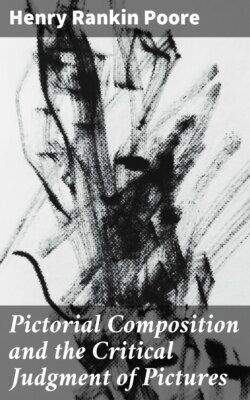Читать книгу Pictorial Composition and the Critical Judgment of Pictures - Henry Rankin Poore - Страница 12
На сайте Литреса книга снята с продажи.
APPARENT OR FORMAL BALANCE.
ОглавлениеTable of Contents
Raphael is a covenient point at which to commence a study of composition. His style was influenced by three considerations: warning by the pitfalls of composition into which his predecessors had fallen; confidence that the absolutely formal balance was safe; and lack of experience to know that anything else was as good. To these may be added the environment for which most of his works were produced. His was an architectural plan of arrangement, and this well suited both the dignity of his subject and the chaste conceptions of a well poised mind.
Raphael, therefore, stands as the chief exponent of informal composition. His plan was to place the figure of greatest importance in the centre. This should have its support in balancing figures on either side; an attempt then often observable was to weaken this set formality by other objects wherein, though measure responded to measure, there was a slight change in kind or degree, the whole arrangement resembling that of an army in battle array; with its centre, flanks and skirmishers. The balance of equal measures—seen in his “Sistine Madonna,” is conspicuous in most ecclesiastical pictures of that [pg 47] period, notably the “Last Supper of Leonardo” in which two groups of three persons each are posed on either side of the pivotal figure.
This has become the standard arrangement for all classical balanced composition in pictorial decoration. The doubling of objects on either side of a central figure not only gives to it importance, but contributes to the composition that quietude, symmetry and solemnity so compatible with religious feeling or decorative requirement. The objection to this plan of balance is that it divides the picture into equal parts, neither one having precedence, and the subdivisions may be continued indefinitely. For this reason it has no place in genre art. Its antiphonal responses belong to the temple. A more objectionable form of balance on the centre is that in which the centre is of small importance. This cuts the picture into halves without reason. The “Dutch Peasants on the Shore,” “Low Tide,” and “The Poulterers,” and David's “Rape of the Sabine Women,” are examples.
These pictures present three degrees of formal balance. In the first a lack of sequence impairs the picture's unity. In the second, though the objects are contiguous there is no subjective union, and in David's composition the formality of the decorative structure is inapplicable to the theme.
The circular group of Dagnan-Bouveret's “Pardon in Brittany,” where the peasants are squatted on the left in the foreground is a daring bit of balance, finding its justification in the [pg 48] movement of interest toward the right in the background.
In all forms, save the classic decoration it should be the artist's effort to conceal the balance over the centre.
In avoiding the equal divisions of the picture plane a practical plan of construction is based upon the strong points as opposed to the weak ones. It assumes that the weak point is the centre, and that in all types of composition where formality is not desired the centre is to be avoided. Any points equidistant from any two sides are also weak points. The inequalities in distance should bear a mathematical ratio to each other as one and two-thirds, two and three-fifths. These points will be strongest and best adapted for the placement of objects which are distant from the boundary lines and the corners, in degrees most varied.
[pg 48]
If we take a canvas of ordinary proportion, namely, one whose length is equal to the hypothenuse on the square of its breadth, as 28×36 or 18×24 and divide it into unequal divisions as three, five or seven, we will produce points on which good composition will result.
The reason for this is that the remaining two-thirds becomes a unit as has the one-third. If the larger is given the precedence it carries the interest; if not it must be sacrificed to the smaller division. On this principle it may be seen that a figure could occupy a position in the centre if it tied itself in a positive way to that division which carried the remainder of the interest thus becoming unobjectionable as an element dividing the picture into equal parts.
The formula is always productive of excellent results. (See Howard's “Sketcher's Manual.”)
This proportional division of the picture one may find in the best of Claude Lorraine's landscapes, with him a favorite method of construction. It suggests the pillars and span for a suspension trestle. When, as is invariably seen in Claude's works the nearest one is in shadow, the vision is projected from this through the space intervening to the distant and more attractive one. A feeling of great depth is inseparable from this arrangement.
